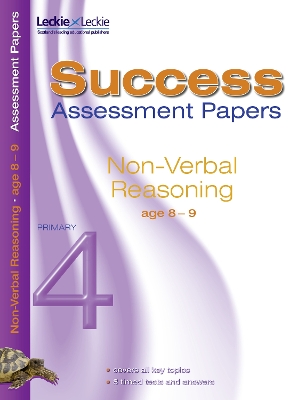Assessment Papers
4 total works
This book contains 8 assessment papers. Each paper contains a range of question types using shapes, pictures and patterns. The simple layout is similar to that used in many exam papers. The papers therefore, help children to become familiar with the question types and to become more confident tackling these types of tests.
Non-verbal reasoning assesses a child's ability to see patterns and relationships, independent of language or prior learning. The tests are particularly helpful for children who may have specific difficulties with literacy, or for whom English is an additional language. They provide a clear indication of a child's ability to identify and work successfully with abstract concepts.
The papers can be used as timed assessment tests or worked through a little at a time for regular non-verbal reasoning practice. Initially, it is better to focus on accuracy, then, as your child gains confidence, working at speed can be developed.
Use the pull-out answer booklet to mark completed papers. Children can use the score boxes in the margin to make a note of their marks for each section. They then record their overall scores on the progress grid at the back of the book. It is a good idea to work through completed papers with your child then you can identify any areas of weakness or confusion and discuss those questions together.
This book contains 8 assessment papers. Each paper contains a range of question types using shapes, pictures and patterns. The simple layout is similar to that used in many exam papers. The papers therefore, help children to become familiar with the question types and to become more confident tackling these types of tests.
Non-verbal reasoning assesses a child's ability to see patterns and relationships, independent of language or prior learning. The tests are particularly helpful for children who may have specific difficulties with literacy, or for whom English is an additional language. They provide a clear indication of a child's ability to identify and work successfully with abstract concepts.
The papers can be used as timed assessment tests or worked through a little at a time for regular non-verbal reasoning practice. Initially, it is better to focus on accuracy, then, as your child gains confidence, working at speed can be developed.
Use the pull-out answer booklet to mark completed papers. Children can use the score boxes in the margin to make a note of their marks for each section. They then record their overall scores on the progress grid at the back of the book. It is a good idea to work through completed papers with your child then you can identify any areas of weakness or confusion and discuss those questions together.
This book contains 8 assessment papers. Each paper contains a range of question types using shapes, pictures and patterns. The simple layout is similar to that used in many exam papers. The papers therefore, help children to become familiar with the question types and to become more confident tackling these types of tests.
Non-verbal reasoning assesses a child's ability to see patterns and relationships, independent of language or prior learning. The tests are particularly helpful for children who may have specific difficulties with literacy, or for whom English is an additional language. They provide a clear indication of a child's ability to identify and work successfully with abstract concepts.
The papers can be used as timed assessment tests or worked through a little at a time for regular non-verbal reasoning practice. Initially, it is better to focus on accuracy, then, as your child gains confidence, working at speed can be developed.
Use the pull-out answer booklet to mark completed papers. Children can use the score boxes in the margin to make a note of their marks for each section. They then record their overall scores on the progress grid at the back of the book. It is a good idea to work through completed papers with your child then you can identify any areas of weakness or confusion and discuss those questions together.
This book contains 8 assessment papers. Each paper contains a range of question types using shapes, pictures and patterns. The simple layout is similar to that used in many exam papers. The papers therefore, help children to become familiar with the question types and to become more confident tackling these types of tests.
Non-verbal reasoning assesses a child's ability to see patterns and relationships, independent of language or prior learning. The tests are particularly helpful for children who may have specific difficulties with literacy, or for whom English is an additional language. They provide a clear indication of a child's ability to identify and work successfully with abstract concepts.
The papers can be used as timed assessment tests or worked through a little at a time for regular non-verbal reasoning practice. Initially, it is better to focus on accuracy, then, as your child gains confidence, working at speed can be developed.
Use the pull-out answer booklet to mark completed papers. Children can use the score boxes in the margin to make a note of their marks for each section. They then record their overall scores on the progress grid at the back of the book. It is a good idea to work through completed papers with your child then you can identify any areas of weakness or confusion and discuss those questions together.



